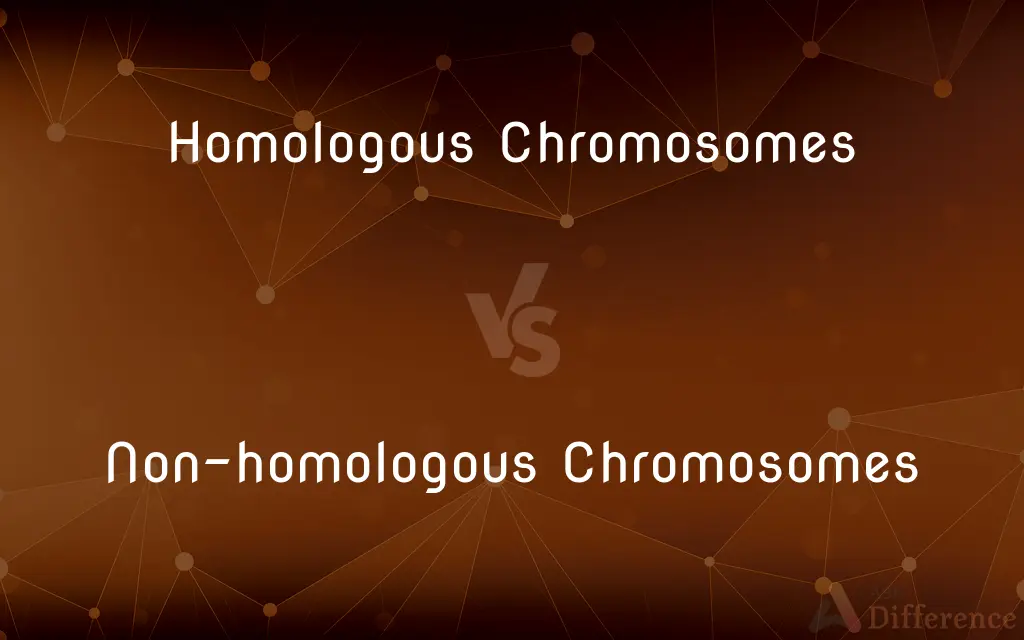Homologous Chromosomes vs. Non-homologous Chromosomes — What's the Difference?
By Tayyaba Rehman — Published on October 30, 2023
Homologous chromosomes are pairs of chromosomes, one from each parent, with genes for the same traits. Non-homologous chromosomes are different chromosomes that do not code for the same genetic information.

Difference Between Homologous Chromosomes and Non-homologous Chromosomes
Table of Contents
ADVERTISEMENT
Key Differences
Homologous chromosomes represent a matching pair, wherein one is inherited from the mother and the other from the father. They carry genes for the same traits, although the specific genetic code might vary. Non-homologous chromosomes, contrastingly, refer to distinct chromosomes from different pairs, not having a shared gene or trait correspondence.
Every individual has pairs of homologous chromosomes that align during meiosis, facilitating the exchange of genetic material. This process of exchange is called recombination, contributing to genetic diversity in offspring. Non-homologous chromosomes, in this context, do not engage in this precise manner of exchange, given their distinct genetic content.
When errors occur during cell division, it's possible for pieces of chromosomes to transfer inappropriately. If segments of homologous chromosomes swap, it's a typical recombination. However, if segments between non-homologous chromosomes exchange, it's termed a translocation, which can lead to genetic disorders.
To visualize this, imagine each homologous chromosome pair as a matching set of shoes, identical in function but slightly varied in detail. Meanwhile, non-homologous chromosomes would be like comparing a shoe to a hat, each having entirely different functions and attributes.
In genetic studies and diagnostics, it's pivotal to differentiate between homologous chromosomes and non-homologous chromosomes. The former offers insights into genetic variation within traits, while the latter can help identify structural chromosomal alterations affecting health.
ADVERTISEMENT
Comparison Chart
Definition
Matching pair of chromosomes from each parent.
Different chromosomes that don't pair up during meiosis.
Gene Content
Code for the same traits.
Do not code for the same traits.
Interaction during Meiosis
Can align and exchange genetic material.
Do not typically exchange genetic material.
Result of Improper Exchange
Regular recombination.
Translocation, leading to genetic disorders.
Genetic Significance
Contribute to genetic variation in traits.
Can indicate structural chromosomal abnormalities.
Compare with Definitions
Homologous Chromosomes
Paired chromosomes from each parent.
Human cells have 23 pairs of homologous chromosomes.
Non-homologous Chromosomes
Their exchange can cause disorders.
If segments from non-homologous chromosomes swap, it can result in conditions like Down syndrome.
Homologous Chromosomes
Align during meiosis.
Genetic diversity arises when homologous chromosomes exchange segments during recombination.
Non-homologous Chromosomes
Different chromosomes from separate pairs.
A chromosome carrying genetic information for eye color and another for hair color are non-homologous chromosomes.
Homologous Chromosomes
One from mother, one from father.
Each pair of homologous chromosomes consists of one chromosome from the maternal set and one from the paternal set.
Non-homologous Chromosomes
Don't code for the same traits.
Non-homologous chromosomes do not have matching genes or genetic sequences.
Homologous Chromosomes
Code for similar traits.
Homologous chromosomes might carry different versions of a gene, but they affect the same trait.
Non-homologous Chromosomes
Don't pair up in meiosis.
During meiosis, non-homologous chromosomes don't align or exchange genetic material like homologous pairs do.
Homologous Chromosomes
Similar in length and gene location.
Homologous chromosomes have genes arranged in the same order, though the versions of genes might differ.
Non-homologous Chromosomes
Distinct in gene content and function.
Comparing non-homologous chromosomes is like contrasting two entirely different book chapters.
Common Curiosities
How are Non-homologous Chromosomes different?
Non-homologous chromosomes are distinct chromosomes from different pairs and don't code for the same genetic information.
Can Non-homologous Chromosomes exchange material?
Yes, but it's rare, and such exchanges, called translocations, can cause genetic disorders.
How do Homologous Chromosomes function in meiosis?
They align, pairing up, and can exchange genetic material during recombination.
Why are Homologous Chromosomes important for genetic diversity?
They exchange genetic material during meiosis, creating new gene combinations in offspring.
How are genes organized on Homologous Chromosomes?
They are arranged in the same order but can have different gene versions or alleles.
How do scientists study Homologous Chromosomes?
Through karyotyping, where they visualize and analyze chromosome pairs.
Why is it crucial to differentiate between these chromosome types in genetics?
It helps in understanding inheritance patterns, genetic diversity, and diagnosing chromosomal disorders.
What are Homologous Chromosomes?
Homologous chromosomes are paired chromosomes from each parent, carrying genes for the same traits.
Are all chromosomes in a cell homologous?
No, only specific pairs are homologous, while others are non-homologous.
How many pairs of Homologous Chromosomes do humans have?
Humans have 23 pairs of homologous chromosomes.
What happens if Non-homologous Chromosomes exchange material?
It results in translocation, which can lead to genetic disorders.
Can Non-homologous Chromosomes affect health?
Yes, especially if there's a translocation or structural change involving them.
What's the relationship between Homologous Chromosomes and genetic traits?
They carry genes for the same traits, influencing how traits are expressed and inherited.
Are Non-homologous Chromosomes completely different?
Yes, in terms of the traits they code for and their genetic sequences.
Share Your Discovery

Previous Comparison
Shire vs. Council
Next Comparison
Oscar vs. Academy AwardAuthor Spotlight
Written by
Tayyaba RehmanTayyaba Rehman is a distinguished writer, currently serving as a primary contributor to askdifference.com. As a researcher in semantics and etymology, Tayyaba's passion for the complexity of languages and their distinctions has found a perfect home on the platform. Tayyaba delves into the intricacies of language, distinguishing between commonly confused words and phrases, thereby providing clarity for readers worldwide.












































